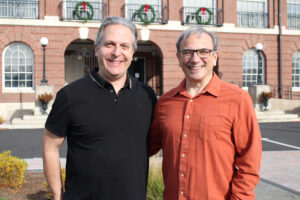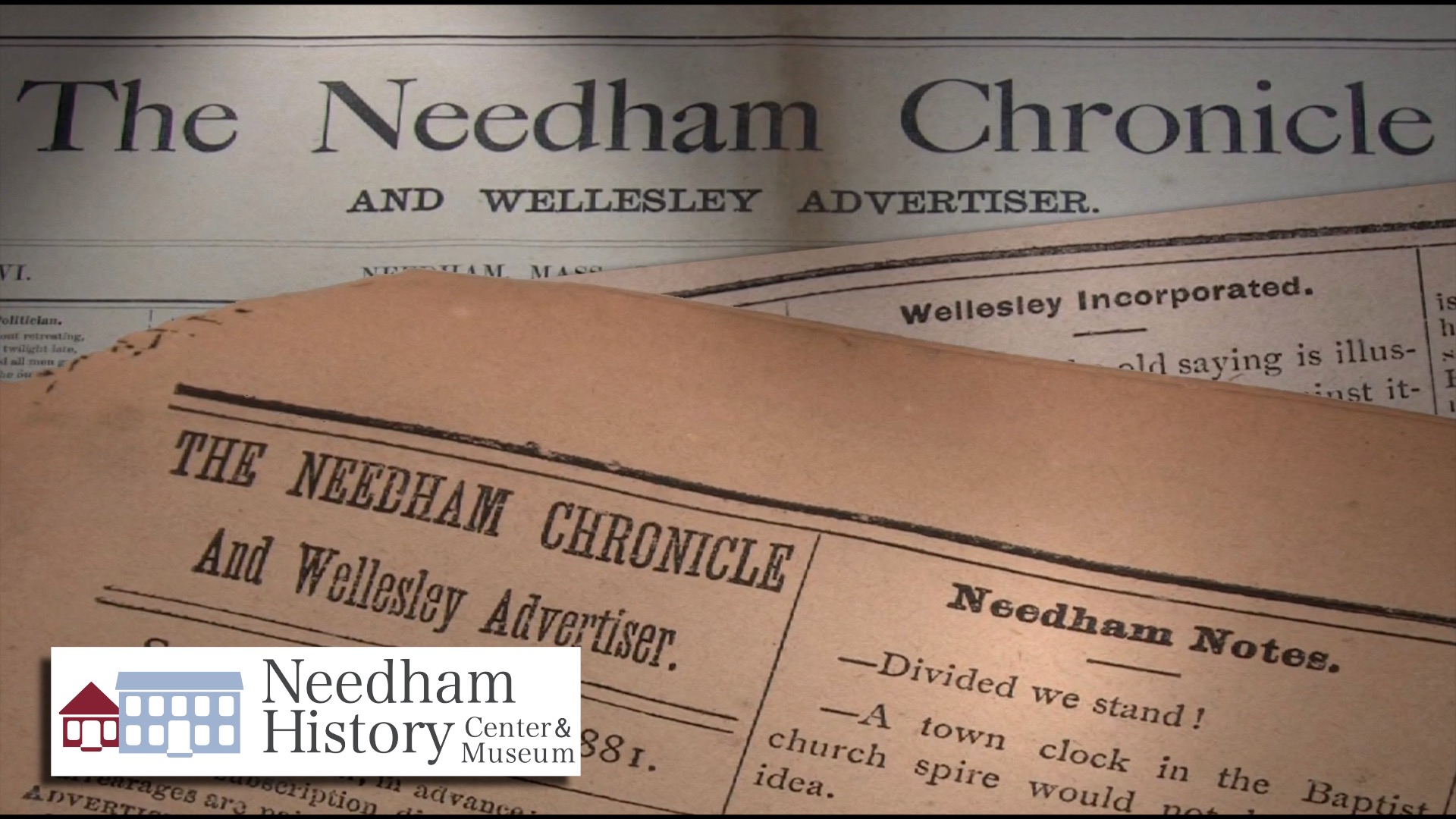
Needham History: Needham vs. Wellesley – The Back Story
Back to a time when the rivalry was darker and more serious…
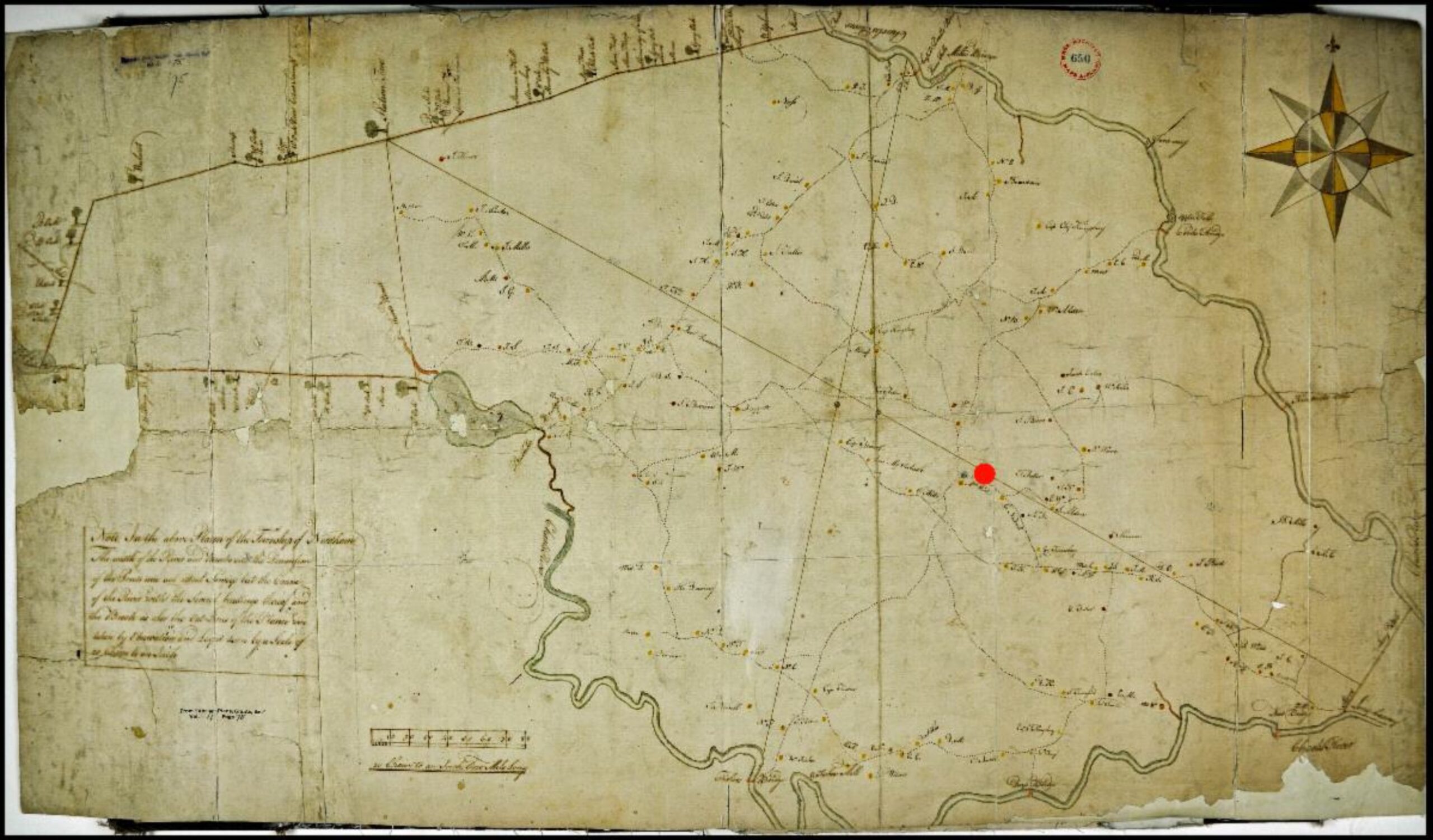
The Barachiah Mason map of Needham, 1771. At the time, the town included both Wellesley and a part of Natick. The red dot indicates the location of the first Meeting House on Nehoiden Street.
Needham vs Wellesley – the Back Story
We think of the Needham-Wellesley rivalry as primarily a football game, but it has always been more than that. It goes back to a time when expressions of the rivalry were darker and more serious.
The dispute actually dates back to around 1720, and has its roots in a disagreement over the location of the new town’s Meeting House. When Needham was founded in 1711, it was much larger, incorporating the land that is now Wellesley, and also a largish chunk of Natick. The location of the church, hence the town center itself, was important – should it be more to the east near the coach roads, or farther to the west beyond North Hill? The coach roads were the major source of transportation, commerce, and communication in an age when travel was difficult and news spread slowly. But with few (and poor) roads, the side of town west of North Hill was more difficult to travel. Therefore, although the absolute distances between a site to the east of North Hill versus a site to the west of North Hill were not great, it was much harder to traverse from the west.
The meeting house ended up in the eastern location on the coach roads, at the intersection of Central Avenue and Nehoiden Street. For nearly 50 years, while old Rev. Townsend and his wife were still alive, there was only grumbling; but after they had passed away, someone sought a more direct tactic – Arson!
On a dark night in October 1774, the Rev. Samuel West awoke to see his church ablaze. Made of wood, and with no nearby source of water to douse it, the building rapidly burnt to the ground.
Looking through my copy of Needham’s Bicentennial Celebration, I found this incident described in the commemorative sermon given in the First Parish Church in Needham by the Reverend William Sleeper, pastor of the Wellesley Congregational Church:
“My story begins in … October of 1773 – the old historic structure that had served the entire population of Needham as their only and sufficient house of worship was burned to the ground. And already the families living toward the West were complaining bitterly because they had to travel so far to attend church. These heroic people of the olden days did not make the distance an excuse for staying away from public worship; but it seemed to them sufficient reason for making a vigorous effort to rebuild the edifice at the center of town [ie, geographical center, farther west, closer to the current Babson College]. But the eloquent voters of the West failed to convince the stalwart men of the East that they ought to pitch their tabernacle in the wilderness, remote from settlements on either side, and we are very glad indeed [No, they really were not. -G] that your church fathers stood manfully by the original location, and brought out a majority vote in favor of rebuilding on the old site. And now I must go on and tell of something which occurred outside of town meeting, and which shows that the men of Needham were early risers, and that determined minorities were not easily discouraged when their heart was fixed.
“It was a morning in August, 1774. The scene was the great social function of the olden times, called “a raising.” The solid frame of the new meeting house had been hewn out and put together, and now it was to be raised and placed on the massive sills … To lift one of these huge structures was no easy work. The entire male population of the town was summoned. But the men of the East were suspicious of their western brethren – and with reason, I regret to say. So at half-past five o’clock in the morning, the men of Needham got at the work, quite in the spirit of Hezekiah’s men as they raised the walls of Jerusalem. At nine o’clock an army of sturdy volunteers from the West appeared on the scene – too late to help – or to hinder! In the journal of the Rev. Samuel West where this incident is recorded, it is said, ‘When they found the work in such forwardness, they were discouraged, and prudently withdrew, although with much resentment and many threats.’”
Rev. Sleeper makes it all sound fairly benign, but tempers ran hot. Hack your way through the flowery language and Biblical references and get to the point – someone in town burned down the Meeting House! The part of the story he dances around is that the arson was almost certainly committed by residents of West Needham, in the hope of getting the location of the meeting house moved westward. As George Kuhn Clarke so blandly observed in his History of Needham, “The feeling in regard to a new meeting house, and its location, had become intense, and had borne its fruit.”
A century earlier, the Rev. Stephen Palmer recounted this event and was equally circumspect. In his Century Sermon, the Rev. Mr. Palmer reviews the town’s brief history. At that time, there were folks still living who had witnessed (and may have been involved in!) the events of October 1773:
“The first meeting house in this town, having stood about sixty-one years, was consumed by fire. This event took place Lord’s Day night, between the 17th and 18th of October, 1773… On the 18th of November following, it was voted in town meeting, that a reward should be given to any one, who should discover the person or persons, concerned in burning the meeting house. But no one was ever apprehended. … It is well known that the locating of this house, like that of the former one, occasioned much uneasiness and contention in the town. But it would be an unpleasant as well as an unpopular task, to bring up to view the debates and difficulties, which then prevailed. The scene has passed away, and many of the actors are gone. The great Head of the Church has already judged numbers of both parties; and there is reason to believe that many of them are now together praising Him…..”
Hmmm – notice he doesn’t say “that ALL of them are now together…” Palmer puts the best possible spin on the situation by also pointing out that the new 1774 structure was able to accommodate a steeple, added onto the building to house the new bell that was commissioned from Paul Revere in honor of Needham’s centennial in 1811. What he could not know in 1811 was that the steeple would eventually destabilize the structure, and that the meeting house had to be rebuilt again in 1836.
Happily, that structure was a sturdy one, withstanding the tempests of both society and weather, and even holding together as it was dragged in 1878 from Nehoiden Street to its current location on Dedham Avenue. And they built it a proper steeple, and they still ring the bell.
The second Meeting House, rebuilt in 1774, after the fire. The building replicated the first Meeting House, with a longhouse structure and central porch. The large steeple was added later to house the 1811 Revere Bell, but it created stresses that destabilized the structure, which had to be demolished and rebuilt in 1836.
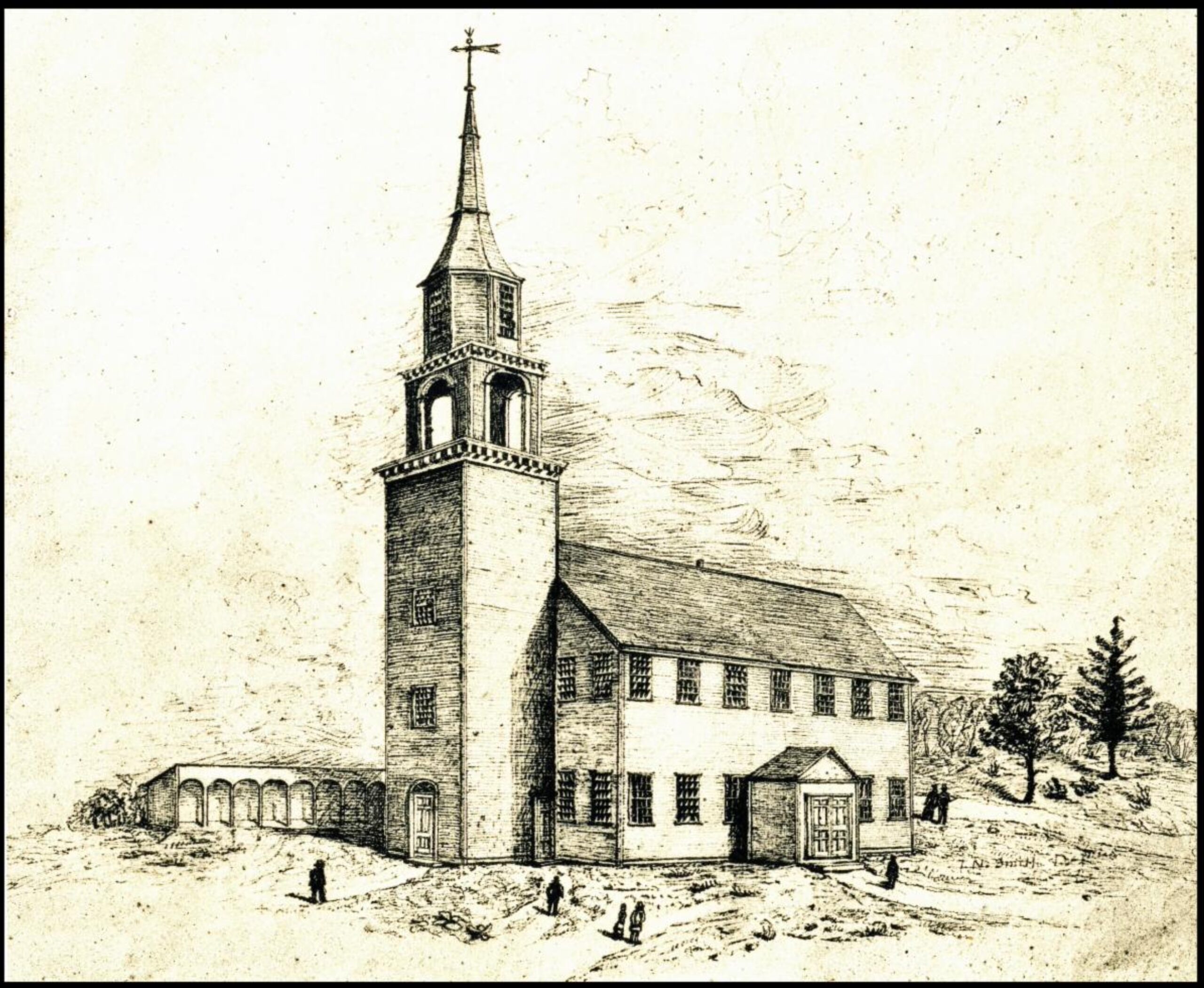
West Needham did get its own parish a few years after the fire. Nevertheless, the bad feeling continued in one form or another. Over the years, the church issues faded, to be overtaken by social and economic differences. The new railroad to Worcester passed through West Needham in the 1830s, and brought some new and more wealthy residents to the West Parish. At the time, Boston was still an island, connected to the mainland by a narrow causeway. The space had been filled long ago, and the city was crowded. It was also filthy, because there was no adequate means to clear out the refuse of so many people in that constrained space. When the milldam was built around the Back Bay in 1814, it was assumed that the daily tidal surges through the dam would flush out the sewage and garbage that were dumped into the bay. How wrong they were – the tidal flow was insufficient for this task, and the Back Bay rapidly became an open sewer. As a result of the good rail service, wealthier residents could escape the city and make their homes (either permanent or seasonal) in the cleaner towns surrounding the city.
Among these new residents in West Needham were Henry Fowle Durant and Horatio Hollis Hunnewell. Hunnewell was a banker and railroad financier, who also had an extensive knowledge of botany. He moved to West Needham to acquire the land for his estate, which included extensive gardens and greenhouses. His topiary garden, the first in the United States, is still flourishing. Durant was an attorney in Boston, who moved out to Wellesley at the urging of his friend, Hunnewell. In 1870, Durant and his wife would provide the funding to found Wellesley College. As the railroad brought new residents out to the West Parish, that side of town took on a slightly different character – more affluent, more rural/residential.
By 1881, those differences became the impetus for the final and greatest upheaval – the decision to split the town. There had been numerous votes in Town Meeting over the years to split the West off into its own town, but since the more populous East Parish had to agree to this as well, they never succeeded. In 1881, Hunnewell, Durant, and another prominent resident of West Needham, Joseph Fiske, made a plan. And the plan was based on the 18th century get-there-first strategy that was employed in the building of the Meeting House.
When Town Meeting met in April 1881, one of the items on the warrant was to separate the West Parish and establish the town to be called Wellesley (a name that Hunnewell had coined some years before, from his wife’s maiden name – Welles.) Although Town Meeting was in the evening, the voters from West Needham showed up early and took the seats, leaving the later-arriving Easterners to fill the aisles and vestibule. When the time came for the vote, the voters from the East were literally shut out of the room, and the warrant article finally passed. The new town of Wellesley was formed right along the old Parish boundary, taking up almost exactly half of the land area and half of the population of the old town, but nearly 60% of the tax base.,/p>
Then in 1882, they challenged us to football game….
A postcard view (circa 1910) of Hunnewell’s topiary Italian Garden beside Lake Waban.
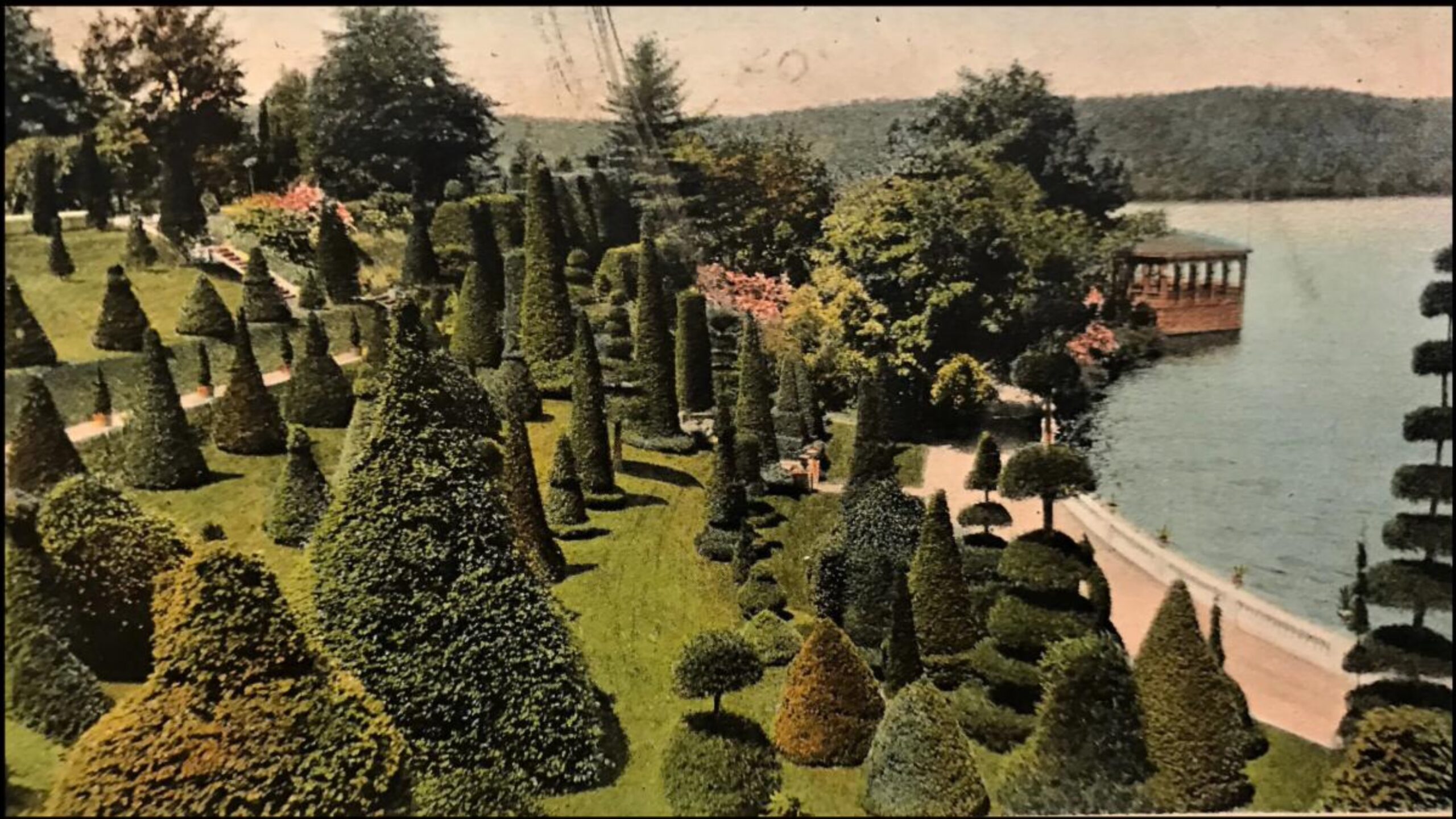
 |
Gloria Polizzotti Greis is the Executive Director of the Needham History Center & Museum. For more information, please see their website at www.needhamhistory.org. |

